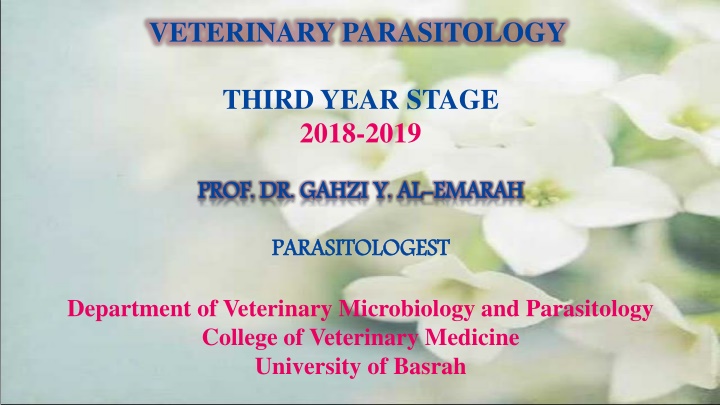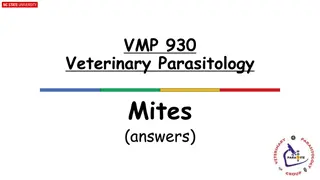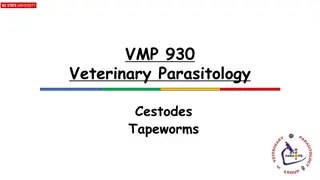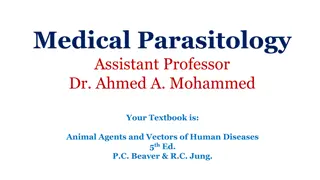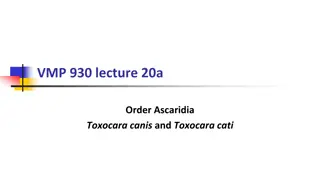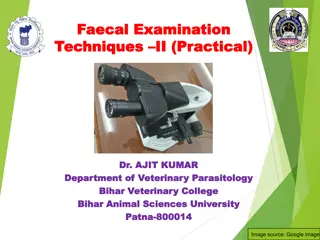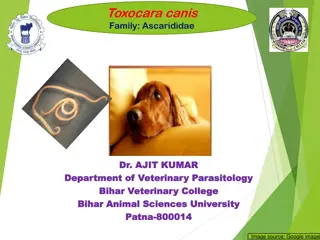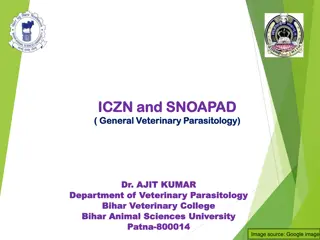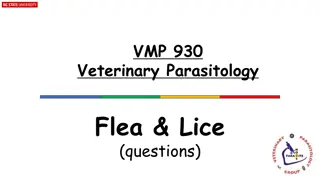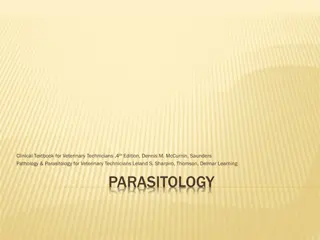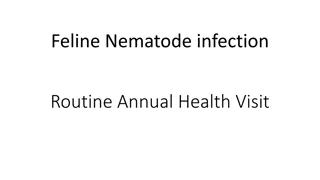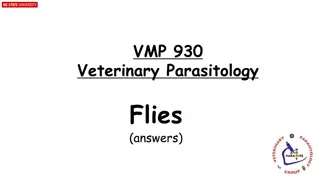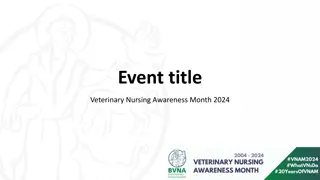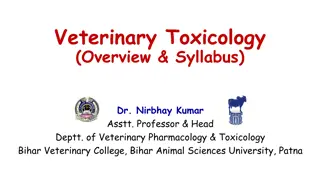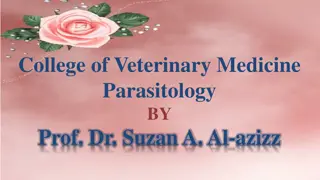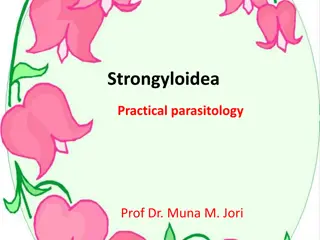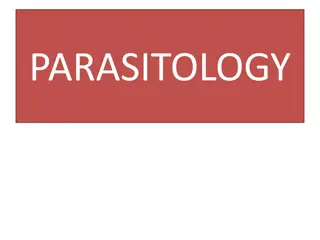Veterinary Parasitology: Nematode Toxocara canis General Characteristics and Life Cycle
Nematodes of the species Toxocara canis are parasitic worms prevalent in the small intestines of dogs and foxes. They exhibit distinct morphological features and a complex life cycle involving various modes of transmission and stages of development. Understanding the lifecycle of T. canis is essential for effective prevention and control strategies in veterinary practice.
Download Presentation

Please find below an Image/Link to download the presentation.
The content on the website is provided AS IS for your information and personal use only. It may not be sold, licensed, or shared on other websites without obtaining consent from the author.If you encounter any issues during the download, it is possible that the publisher has removed the file from their server.
You are allowed to download the files provided on this website for personal or commercial use, subject to the condition that they are used lawfully. All files are the property of their respective owners.
The content on the website is provided AS IS for your information and personal use only. It may not be sold, licensed, or shared on other websites without obtaining consent from the author.
E N D
Presentation Transcript
VETERINARY PARASITOLOGY THIRD YEAR STAGE 2018-2019 PROF. PROF. DR. DR. GAHZI Y. GAHZI Y. AL AL- -EMARAH EMARAH PARASITOLOGEST PARASITOLOGEST Department of Veterinary Microbiology and Parasitology College of Veterinary Medicine University of Basrah
NEMATODA Toxocara canis General Characteristics: - Occurs in the small intestine inside their final host dog and fox. - The males are 10cm long and the females up to18cm. - large cervical alae . - It having three main lips . - The male tail has a terminal narrow appendage and caudal alae . - The female genital organs extend interiorly and posteriorly to the vulvar - The spicules are 0.75-0.95mm long. - The eggs are subglobular with thick ,final pitted shells and measure about 90 by 75Mm.
NEMATODA Toxocara canis Life Cycle The life cycle of T. canis is complex and according to the age of the host may involve: 1- prenatal( transuterine) in female but in male is somatic migrants. 2- by colostral (lactogenic) transmission . 3- direct transmission. 4- by paratenic host. - The female may lay as 2oooo eggs in day. The eggs in the feces of the host. -
NEMATODA Toxocara canis Life Cycle - Develop to the infective stage (second stage larva in egg) in 10-15 days or longer depending on the temperature. - The eggs are very resistant to adverse condition ,like drying or freezing and to chemicals and may remain viable for as long as five years. But sandy soil with direct sunlight kill them in few weak. - The larva has two ecdyses occur before eggs hatch to third stage larva.
NEMATODA Toxocara canis Life Cycle - The infection takes place through ingestion of the eggs with food or water or from the soiled skin of the mother in the case sucking . - The ingested eggs hatch in the dudenum . - The larvae burrow into the wall of the gut. - The larvae passed into the liver through the lymph stream to mesenteric nodes and then by hepatoportal blood stream. - The larvae arrive in the liver in 2 days after infection. - From the liver a larva carried by blood through the heart to the lungs.
NEMATODA Toxocara canis Life Cycle - The larvae are recognizable as third stage larvae between the 4-5 days after infection. - There is one moult in lung and liver. - Larvae break out of alveolar capillary in to the alveolus and pass through the alveolar duct tch o the small bronchioles and then gradually ascend the bronchial tree after than into large bronchi and trachea. - Larvae migrate to the pharynx when they are swallowed and 3ed stage larvae arrived in the intestine through 7-8 after infection.
NEMATODA Toxocara canis Life Cycle of Toxocara canis in Dogs and herbivorous animals
NEMATODA Toxocara canis Life Cycle of Toxocara canis in Dogs and Human as Paratenic Host
NEMATODA Toxocara canis Pathogenicity and Pathogenesis -occur in puppies. 1- Catarrhal enteritis. 2- Intestine obstruction. 3-A depression of albumin synthesis. 4- Hepatic and pulmonary damage caused by larval migration. 5- Circulating eosinophilia. 6- Pnemonia. Clinical Signs 1- Diarrhoea which may be foetid in colour and pale in colour.
NEMATODA Toxocara canis Clinical Signs 2- General malais 3- The coat is harsh 4-Animals may become pot-bellied 5- Coughing 6- Vomiting 7- Death frequently occur 2-3 weeks after birth.
NEMATODA Toxocara canis Diagnosis - Clinical signs. - Faecal exam. - Serological exam. Treatment Anthelmintic used in dog are susceptible adult ascaris Larval stages in the tissues are much less susceptible . Rx, salt of piprazine (dihydrochloride and citrate ), thenium and Ivermctine.
NEMATODA Toxocara canis Visceral Larva Migrans This condition of children is mainly caused by the larvae of T. canis ,though the larval stages of T. leonina ,T. cati, Capillaria hepatica (of rodents),it is characterized by: 1- Chronic granulomatus (usually eosinophilic)lesion in liver, lung, brain ,eye . 2- Enlarged liver. 3- Hepatomegaly. 4- Pulmanary infiltration.
NEMATODA Toxocara canis Visceral Larva Migrans 5- Loss of weight and appetite. 6- Cough. 7- Circular eosinophilia.
NEMATODA Ascaridia galli General Characteristics - Occurs in the small intestine - The host :fowl, guinea fowl turkey, goose and various wild birds in most parts of the world. - The males are 50-76mm long and the females 72-116mm. - It having three large lips . - The male tail has small alae and bears ten pairs of papillae . - The oesophagus has no posterior bulb.
NEMATODA Ascaridia galli General Characteristics - The spicules are sub equal, about 1-2.4mm long. - The eggs are subglobular with thick. Life Cycle - The female may lay eggs. The eggs in the feces of the host. - - Develop to the infective stage(second stage larva in egg) in 10 days or longer depending on the temperature.
NEMATODA Ascaridia galli - The eggs are very resistant to adverse condition ,like drying or freezing and to chemicals and may remain viable for as long as three months. But dry ,hot weather killed the eggs. - The larva has two ecdyses occur before eggs hatch to third stage larva. - The infection takes place through ingestion of the eggs with food or water sucking - The ingested eggs hatch in the intestine .
NEMATODA Ascaridia galli - The larvae burrow into the wall of the gut after eight days. - The larvae passed into the intestine mucosa from the eighth to the seventeenth days. - The larvae reenter the lumen and reach maturity in six to eight weeks according to the age of the host may involve . - The larvae are recognizable as third stage larvae between the 4days after infection , but L4 at 14-15days.
NEMATODA Life Cycle of Ascaridia galli
NEMATODA Ascaridia galli Pathogenicity and Pathogenesis - Young birds are more susceptible to infection than adult birds chickens over three month of age are more resistant to infection ,marked lesion may be produced when large numbers of parasites. 1- enteritis. 2-intestine obstruction. 3-they cause haemorrhage. 4-pnemonia.
NEMATODA Ascaridia galli Clinical Signs 1- Diarrhoea. 2- The birds become unthrifty. 3- Markedly emaciated. 4- Generally weak and egg production is decreased. Diagnosis - Clinical signs. - Faecal exam. - Serological exam.
NEMATODA Ascaridia galli Treatment Rx, salt of piprazine (dihydrochloride and citrate ) and Albendazoal.
THANK THANK YOU YOU
